Sustainable Digital Rural Development: Measurements, Dynamic Evolutions, and Regional Disparities—A Case Study of China
Abstract
1. Introduction
- A more comprehensive evaluation index system for digital rural development:
- 2.
- Multidimensional analysis of development dynamics:
- 3.
- Dual geographical perspectives:
2. Materials and Methods
2.1. Data Source
2.2. Methods
2.2.1. Construction and Evaluation Method of the Digital Rural Indicator System
2.2.2. Kernel Density Estimation
2.2.3. Decomposition of Dagum Gini Coefficient
2.2.4. Obstacle Degree Model
3. Results
3.1. Analysis of Measurement Results
3.1.1. National Level
3.1.2. Regional Level
3.1.3. Provincial Level
3.2. Analysis of the Characteristics of Dynamic Evolution of the Distribution of Levels of Digital Rural Development in China
3.2.1. National Level
3.2.2. Regional Level
3.3. Spatial Decomposition of Disparities in Digital Rural Development Levels in China
3.3.1. Analysis of General Disparity
3.3.2. Analysis of Intra-Regional Disparities
3.3.3. Analysis of Inter-Regional Disparities
3.3.4. Sources and Contributions of Differences
3.4. Diagnosis of Obstacle Factors Affecting the Level of Development of Digital Villages in China
3.4.1. Identification of Obstacles at the Subsystems Level of the Indicator System
3.4.2. Identification of Barrier Factors at the Secondary Index Level of the Indicator System
3.4.3. Analysis of Barrier Factors
4. Discussion
- The entropy weight method is first used to evaluate the level of digital village development in China. Our research findings show that between 2013 and 2022, our country’s overall development of digital rural areas had a swinging upward trajectory, with an average annual growth rate of 9.432%. The development trends of digital rural areas in the five regions are closely similar to the national level, with a significant fall in 2019, while the other years had an upward trajectory. Notably, notable discrepancies are evident at the province level, especially between Hainan (0.040) and Guangdong (0.330).
- Then, this research uses kernel density estimation to analyze the distributional dynamics of digital village growth in China. From the view of distribution dynamics, improving digital rural development levels across the country and the five major regions are accompanied by a trend of distribution becoming more dispersed. A decrease in the kernel density curve’s peak and an increase in its width serve as proof of this. In particular, extensibility is higher nationally and in the northern region, whereas multipolarity is still in the eastern region. On the other hand, there is a tendency toward bipolar to multipolarity nationally and in the other four areas. Regional development inequalities are chiefly ascribed to differences in resource endowments, governmental support, and infrastructure quality. This intensifies the Matthew effect, in which the privileged added more benefits while the underprivileged lagged further behind.
- This study utilizes the Dagum Gini coefficient and its decomposition method to thoroughly clarify the dynamics of spatial disparities and their origins in the emergence of digital villages in China. The research findings show that the growing imbalance in developing digital rural areas in our country is highlighted by the widening regional differences in the development of digital rural areas. The North–South discrepancies are mainly attributed to intra-regional variances, while the East–West differences are largely due to inter-regional disparities. Disparities are evident both intra-regional and inter-regional to differing extents.
- This study uses an obstacle degree model to identify the primary barriers to digital village development in China. The analysis of barriers suggests that the primary obstacle affecting the development of digital rural areas in China during the sample period is developing the rural digital industry within the subsystem layer. This obstacle mainly arises from four critical domains: uneven regional e-commerce advancement, inadequate infrastructure in central and western regions, subpar development of agricultural product quality and branding, and a homogeneous structure in e-commerce transactions. From a time series perspective, the swings in the barriers across various subsystem layers are relatively minor, yet their trends display significant differences: the barriers associated with the development of the rural digital industry and the digitalization of agricultural production show an overall upward trend, while the barriers on the rural digital development environment and rural digital infrastructure show a downward trajectory. With identifying barriers at the secondary index level, the number of Taobao villages emerges as the leading obstacle. For the eastern region, the top five causes hindering the development of digital rural areas are as follows: the number of Taobao villages, e-commerce procurement amount, e-commerce sales amount, rural postal and telecommunications service volume, and local fiscal science and technology expenditure. The barrier reasons in other regions align with those in the eastern region, although there is a reversal in the rank of the fourth and fifth causes compared to the eastern region.
5. Recommendations
Author Contributions
Funding
Institutional Review Board Statement
Informed Consent Statement
Data Availability Statement
Conflicts of Interest
References
- Saleh, N. Digitally Enabled Social Change: Activism in the Internet Age. Perspect. Politics 2012, 10, 514–515. [Google Scholar] [CrossRef]
- Adamowicz, M.; Zwolińska-Ligaj, M. The “Smart Village” as a Way to Achieve Sustainable Development in Rural Areas of Poland. Sustainability 2020, 12, 6503. [Google Scholar] [CrossRef]
- China Digital Village Development Report. 2022. Available online: https://www.cac.gov.cn/rootimages/uploadimg/1679309718522950/1679309718522950.pdf (accessed on 1 February 2023).
- Xi Jinping: Upholding the Great Banner of Socialism with Chinese Characteristics to Unite and Strive for the Comprehensive Construction of a Modern Socialist Country—Report at the 20th National Congress of the Communist Party of China. Available online: https://www.gov.cn/xinwen/2022-10/25/content_5721685.htm (accessed on 25 October 2022).
- Zhang, X.; Zhang, Z. How Do Smart Villages Become a Way to Achieve Sustainable Development in Rural Areas? Smart Village Planning and Practices in China. Sustainability 2020, 12, 10510. [Google Scholar] [CrossRef]
- Chanak, P.; Banerjee, I. Internet-of-Things-Enabled SmartVillages: An Overview. IEEE Consum. Electron. Mag. 2021, 10, 12–18. [Google Scholar] [CrossRef]
- Streimikis, J.; Miao, Z.; Balezentis, T. Creation of climate-smart and energy-efficient agriculture in the European Union: Pathways based on the frontier analysis. Bus. Strategy Environ. 2021, 30, 576–589. [Google Scholar] [CrossRef]
- Nam, Y.C. Smart Service and Progressive Strategies of a Smart Village Project in Rural Area-A Case Study of Geumsan-gun. J. Korean Inst. Rural Archit. 2022, 24, 37–44. [Google Scholar] [CrossRef]
- García Fernández, C.; Peek, D. Connecting the Smart Village: A Switch towards Smart and Sustainable Rural-Urban Linkages in Spain. Land 2023, 12, 822. [Google Scholar] [CrossRef]
- Digital Village Development Strategy Outline. Available online: https://www.gov.cn/zhengce/2019-05/16/content_5392269.htm (accessed on 16 May 2019).
- Digital Agriculture and Rural Development Plan (2019–2025). Available online: http://www.moa.gov.cn/gk/ghjh_1/202001/t20200120_6336316.htm (accessed on 20 January 2020).
- Digital Village Development Action Plan (2022–2025). Available online: https://www.cac.gov.cn/2022-01/25/c_1644713315749608.htm (accessed on 26 January 2022).
- Digital Village Construction Guide-Lines 1.0. Available online: https://www.cac.gov.cn/2021-09/03/c_1632256398120331.htm (accessed on 3 September 2021).
- Digital Village Construction Guide-Lines 2.0. Available online: https://www.cac.gov.cn/2024-05/15/c_1717449042791246.htm (accessed on 16 May 2024).
- Zhao, W.; Liang, Z.; Li, B. Realizing a Rural Sustainable Development through a Digital Village Construction: Experiences from China. Sustainability 2022, 14, 14199. [Google Scholar] [CrossRef]
- Liu, Y.; Dai, Z.; Zhao, X. Unveiling the blueprint for rural digital prosperity: A comparative examination of top 100 digital counties in China. Technol. Forecast. Soc. Change 2024, 208, 123625. [Google Scholar] [CrossRef]
- Li, X.; Singh Chandel, R.B.; Xia, X. Analysis on Regional Differences and Spatial Convergence of Digital Village Development Level: Theory and Evidence from China. Agriculture 2022, 12, 164. [Google Scholar] [CrossRef]
- Li, Y.; Wen, X. Regional unevenness in the construction of digital villages: A case study of China. PLoS ONE 2023, 18, e0287672. [Google Scholar] [CrossRef] [PubMed]
- Cao, X.; Yan, M.; Wen, J. Exploring the Level and Influencing Factors of Digital Village Development in China: Insights and Recommendations. Sustainability 2023, 15, 10423. [Google Scholar] [CrossRef]
- Liu, H.; Zhang, Y.; Wang, S.; Zhao, H. Comprehensive evaluation of digital village development in the context of rural revitalization: A case study from Jiangxi Province of China. PLoS ONE 2024, 19, e0303847. [Google Scholar] [CrossRef]
- Leong, C.; Pan, S.L.; Newell, S.; Cui, L.L. The Emergence of Self-Organizing E-Commerce Ecosystems in Remote Villages of China: A Tale of Digital Empowerment for Rural Development. Mis Q. 2016, 40, 475–484. [Google Scholar] [CrossRef]
- Bielska, A.; Stańczuk-Gałwiaczek, M.; Sobolewska-Mikulska, K.; Mroczkowski, R. Implementation of the smart village concept based on selected spatial patterns–A case study of Mazowieckie Voivodeship in Poland. Land Use Policy 2021, 104, 105366. [Google Scholar] [CrossRef]
- Li, W.; Zhang, P.; Zhao, K.X.; Chen, H.; Zhao, S.D. The Evolution Model of and Factors Influencing Digital Villages: Evidence from Guangxi, China. Agriculture 2023, 13, 659. [Google Scholar] [CrossRef]
- Liu, Q. Index system establishment and empirical study of digital rural development level: Taking panel data of 18 prefecture-level cities in Henan province from 2014 to 2021 as an example. Southwest China J. Agric. Sci. 2023, 36, 885–896. [Google Scholar]
- Xing, Z.; Zhao, S.; Wang, D. Performance and sustainability evaluation of rural digitalization and its driving mechanism: Evidence from Hunan province of China. Front. Environ. Sci. 2023, 11, 22. [Google Scholar] [CrossRef]
- Zhang, P.; Li, W.; Zhao, K.; Zhao, Y.; Chen, H.; Zhao, S. The Impact Factors and Management Policy of Digital Village Development: A Case Study of Gansu Province, China. Land 2023, 12, 616. [Google Scholar] [CrossRef]
- Zhao, Y.; Li, R. Coupling and Coordination Analysis of Digital Rural Construction from the Perspective of Rural Revitalization: A Case Study from Zhejiang Province of China. Sustainability 2022, 14, 3638. [Google Scholar] [CrossRef]
- Lin, H.; Zhao, L.; Hu, Y. Does the Construction of Digital Villages Promote Common Prosperity in Old Revolutionary Base Areas? Chin. Rural. Econ. 2023, 5, 81–102. [Google Scholar]
- Liu, Y.; Lai, K. Impact of digital village construction on rural revitalization and development: Based on empirical evidence from 1 804 counties in China. Acta Agric. Zhejiangensis 2024, 36, 1694–1708. [Google Scholar]
- Wang, P.; Li, C.; Huang, C.H. The Impact of Digital Village Construction on County-Level Economic Growth and Its Driving Mechanisms: Evidence from China. Agriculture 2023, 13, 1917. [Google Scholar] [CrossRef]
- Kirera, L.K. Role of Smart Villages in Preservation of Farmlands and Rural Livelihoods—A Case of Kimunyu Sub-Location, Gatundu South Sub-County, Kiambu County, Kenya. Ph.D. Thesis, University of Nairobi, Nairobi, Kenya, 2023. [Google Scholar]
- Atieno, L.V.; Moturi, C.A. Implementation of digital village projects in developing countries-case of kenya. Br. J. Appl. Sci. Technol. 2014, 4, 793–807. [Google Scholar] [CrossRef]
- Mei, Y.; Mao, D.; Lu, Y.H.; Chu, W. Effects and mechanisms of rural E-commerce clusters on households’ entrepreneurship behavior in China. Growth Change 2020, 51, 1588–1610. [Google Scholar] [CrossRef]
- Benin, S. Impact of Ghana’s agricultural mechanization services center program. Agric. Econ. 2025, 46, 103–117. [Google Scholar] [CrossRef]
- Xie, W.S.; Song, D.L.; Bi, Y.F. China’s Digital Rural Construction: Internal Mechanism, Connection Mechanism and Practice Path. J. Suzhou Univ. 2022, 43, 93–103. [Google Scholar]
- Deng, X.; Han, Z.; Xie, W.; Wang, G.X.; Fan, Z. Risk evaluation of the grain supply chain in China. Int. J. Logist. Res. Appl. 2024, 83, 102. [Google Scholar] [CrossRef]
- Zhao, J.; Ji, G.; Tian, Y.; Chen, Y.L.; Wang, Z. Environmental vulnerability assessment for mainland China based on entropy method. Ecol. Indic. 2018, 91, 410–422. [Google Scholar] [CrossRef]
- Guo, X.G. Application of improved entropy method in evaluation of economic result. Syst. Eng. Theory Pract. 1998, 12, 99–103. [Google Scholar]
- Cheng, X.; Long, R.; Chen, H.; Li, Q.W. Coupling coordination degree and spatial dynamic evolution of a regional green competitiveness system—A case study from China. Ecol. Indic. 2019, 104, 489–500. [Google Scholar] [CrossRef]
- Dagum, C. A New Approach to the Decomposition of the Gini Income Inequality Ratio. In Empirical Economics; Springer: Berlin, Germany, 1997; Volume 22. [Google Scholar]
- Wang, Q.C.; He, P.; Li, Y.; Hou, Y.; Jian, Y.I.; Liu, X. Towards a human-centric city emergency response: Modelling activity patterns of ur-ban population. Dev. Built Environ. 2025, 21, 100633. [Google Scholar] [CrossRef]
- Wang, Q.-C.; Yu, S.-N.; Chen, Z.-X.; Weng, Y.-W.; Xue, J.; Liu, X. Promoting additive construction in fast-developing areas: An analysis of policies and stakeholder perspectives. Dev. Built Environ. 2023, 16, 100271. [Google Scholar] [CrossRef]
- Zhang, H.; Du, K.W.; Jin, B.Y. Research on evaluation of digital rural development readiness under rural revitalization strategy. Xi’an Univ. Financ. Econ. 2020, 33, 51–60. [Google Scholar]

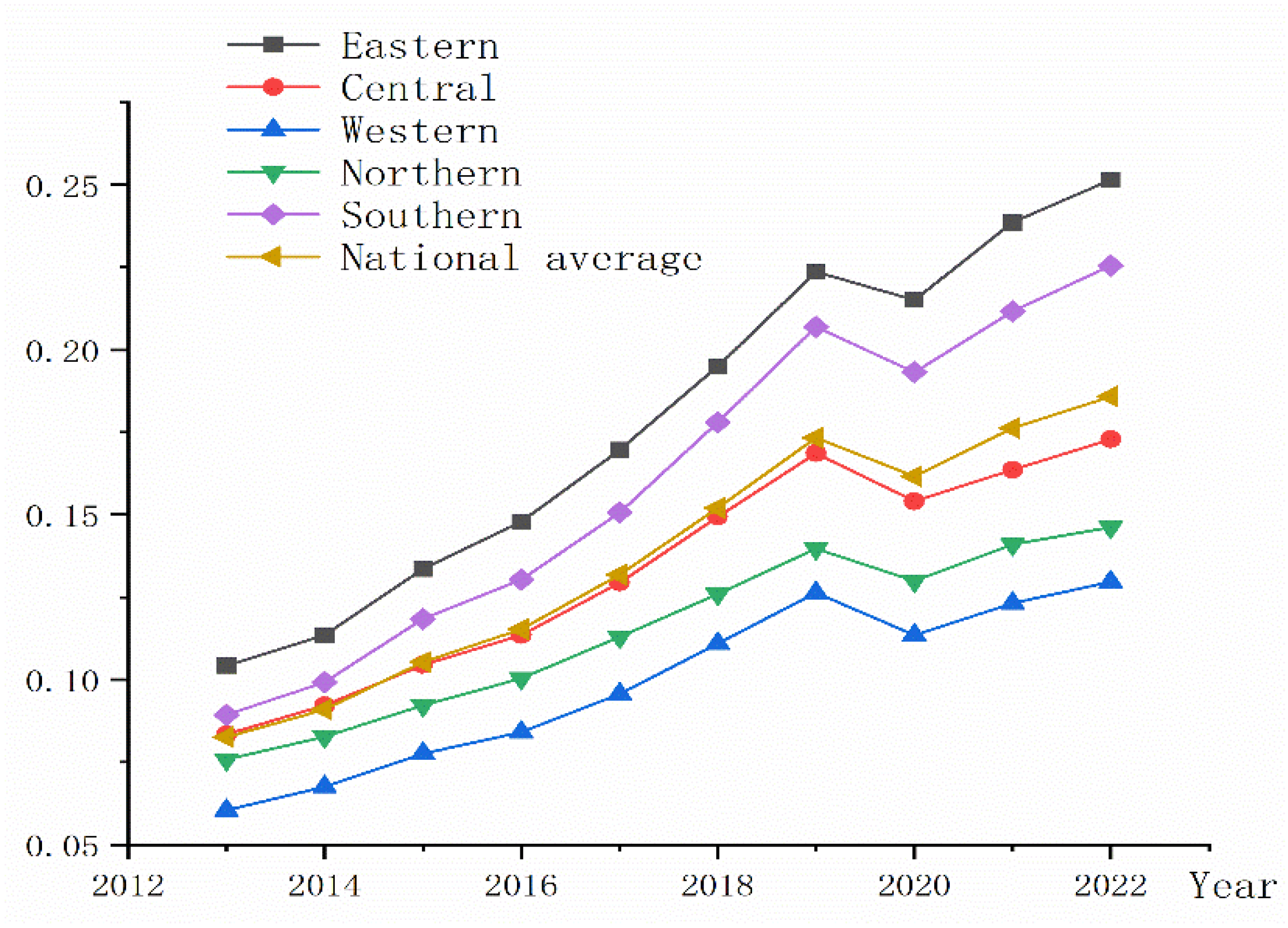
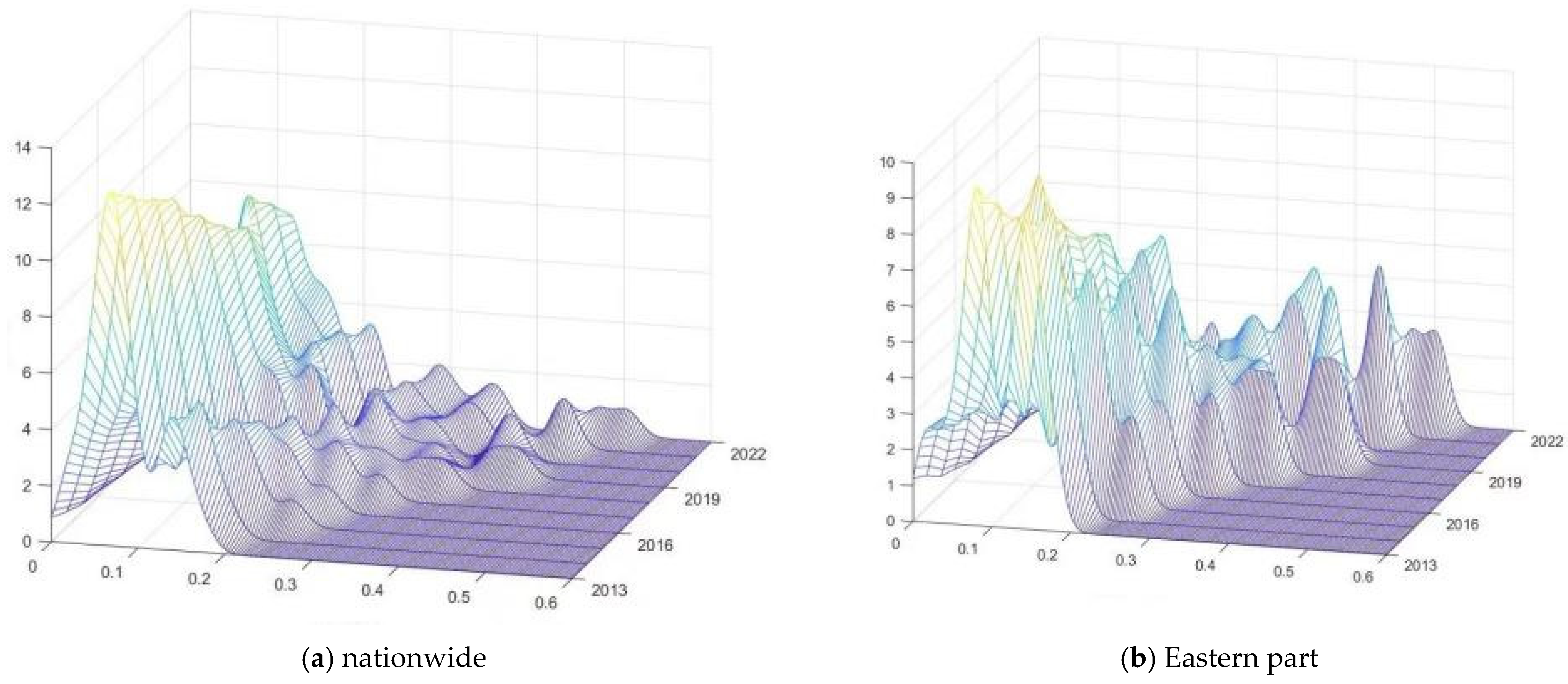
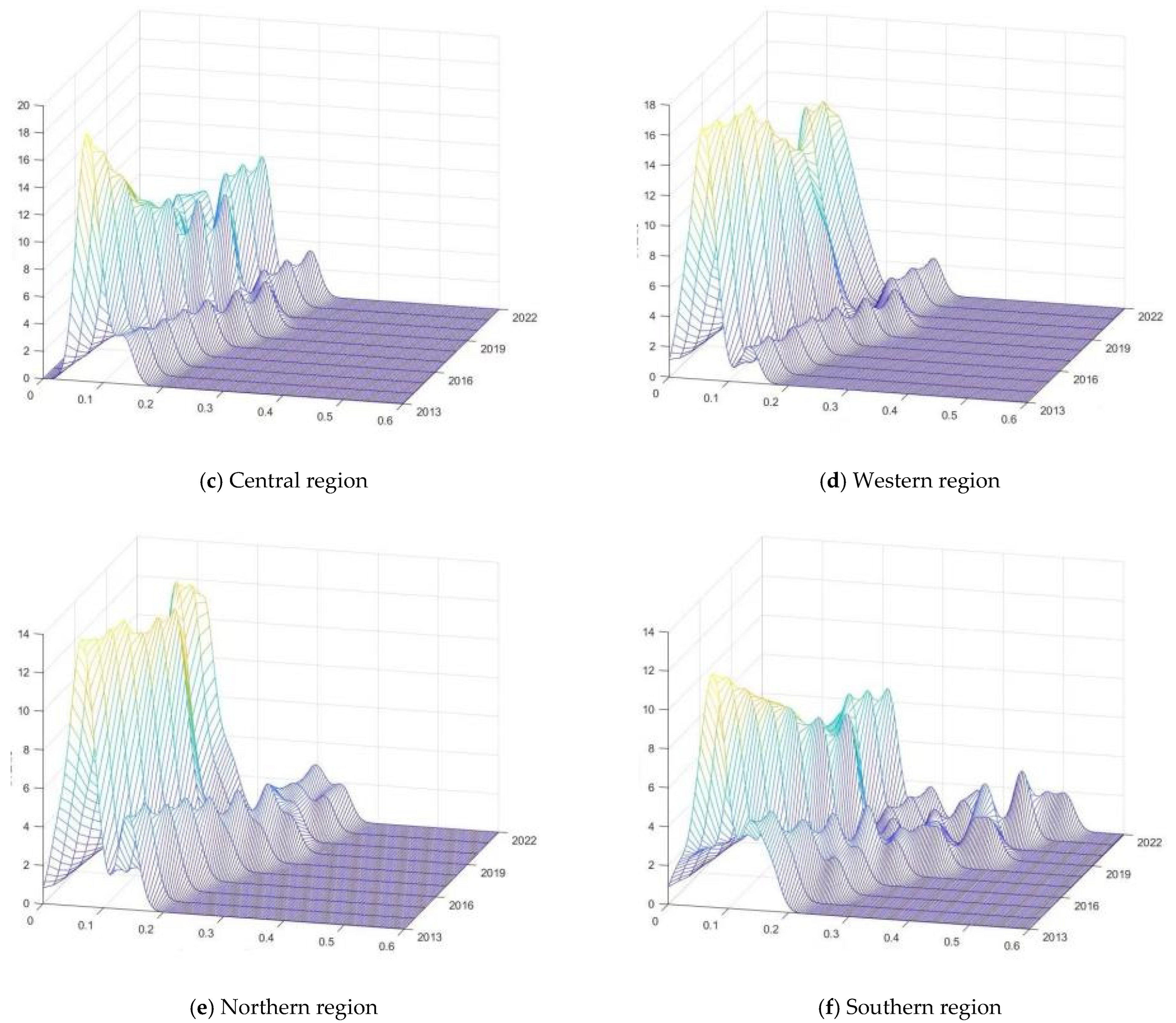
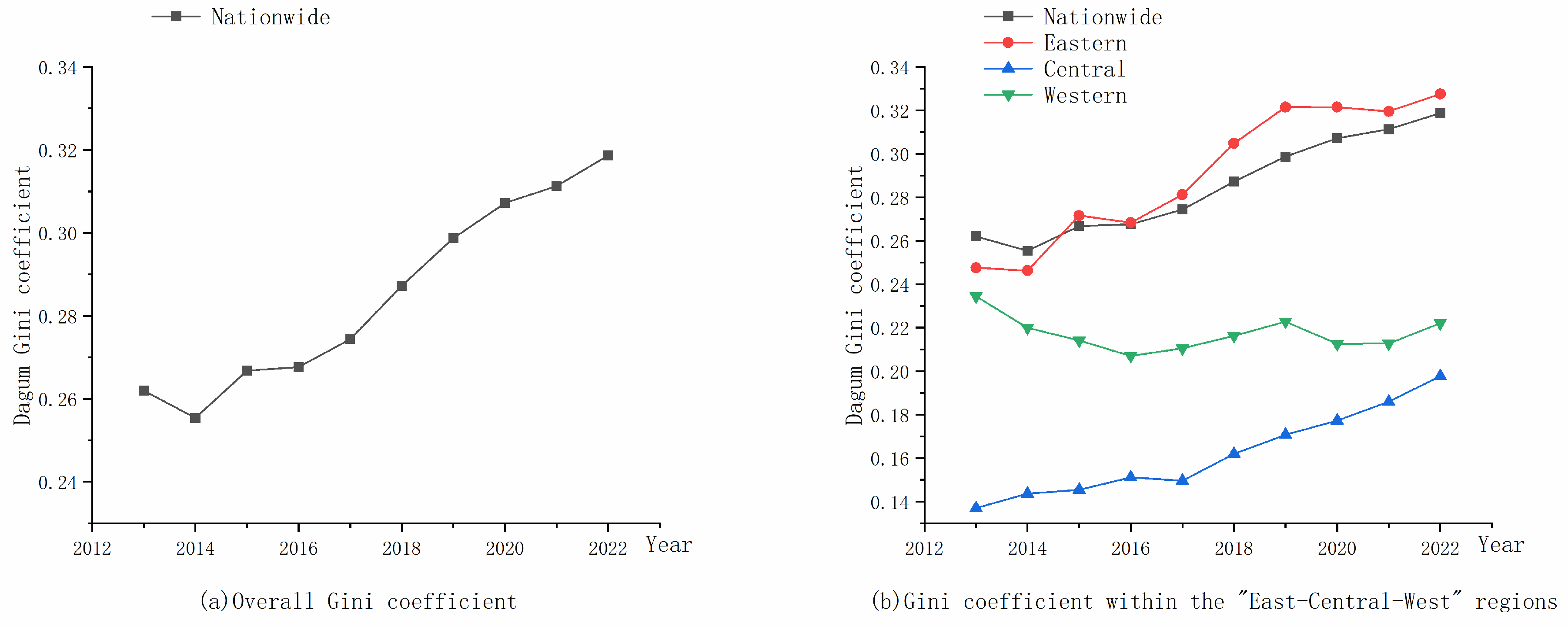
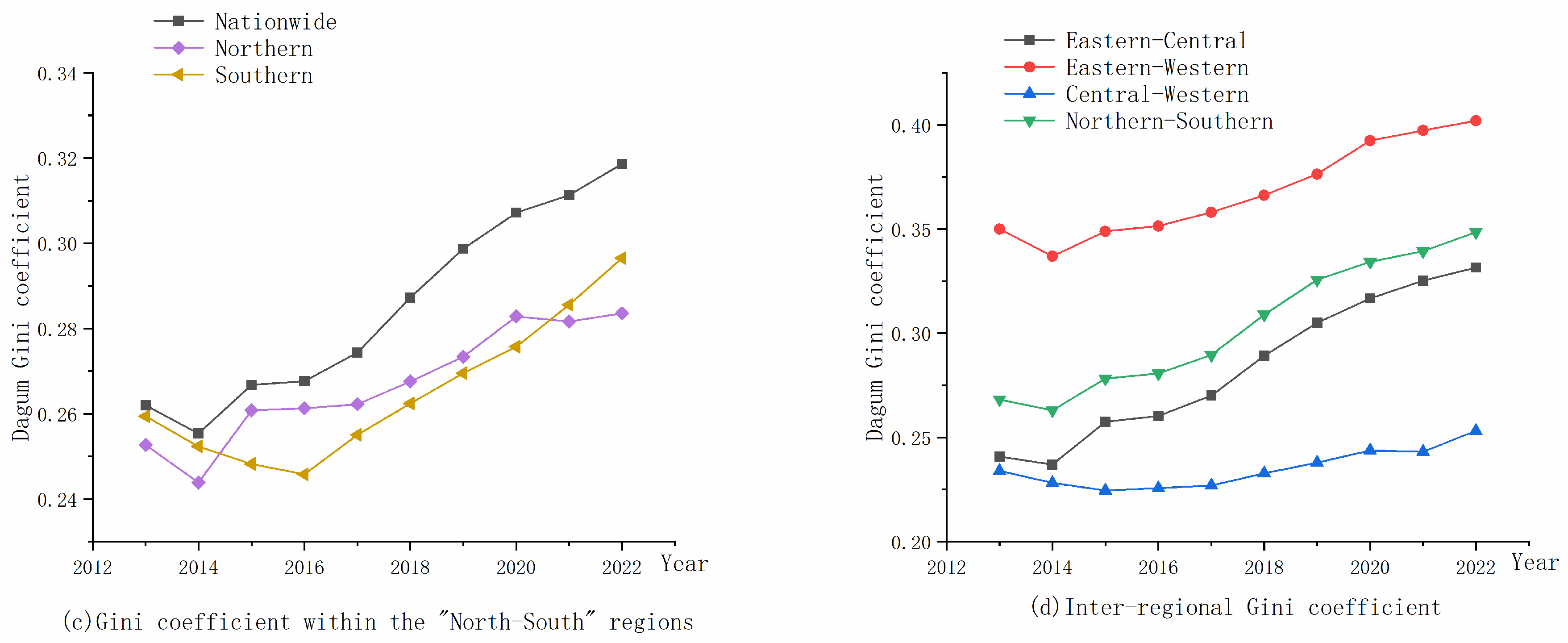
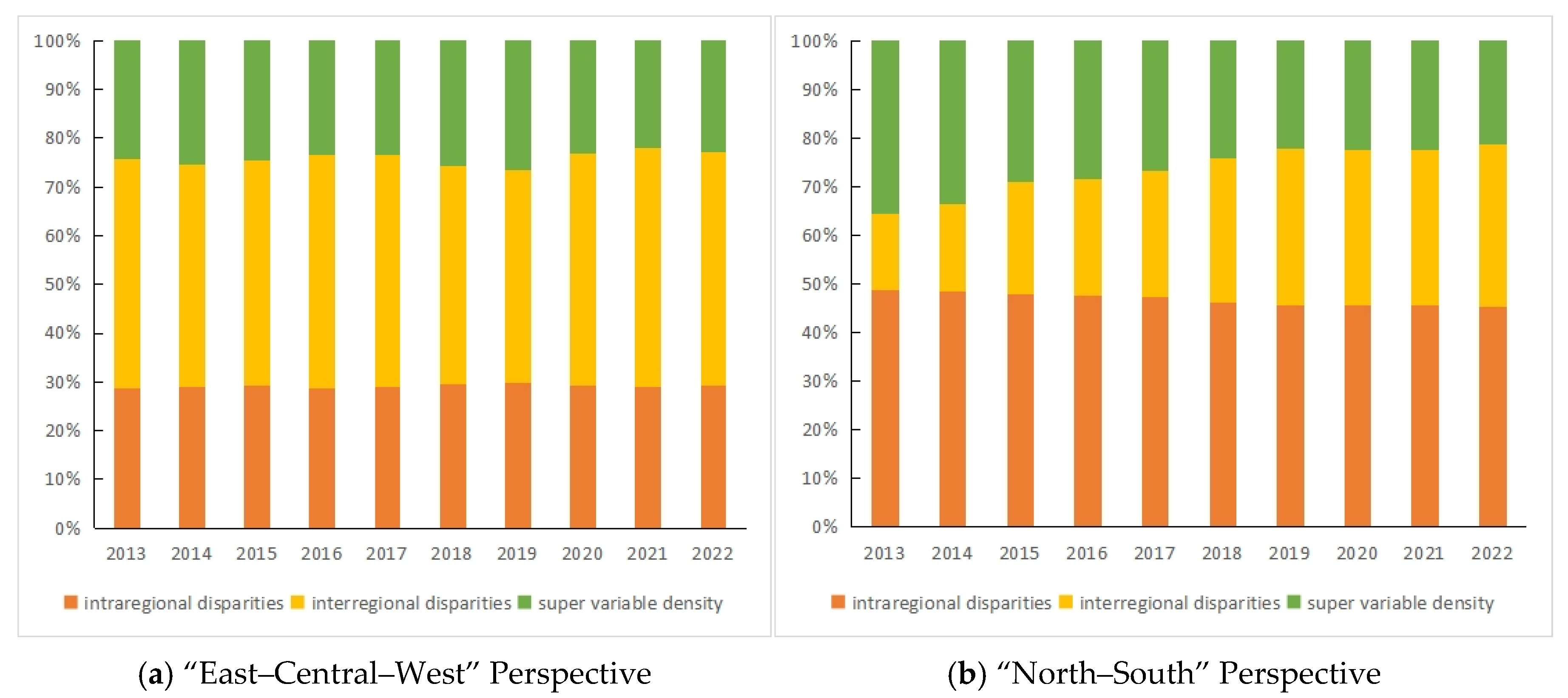

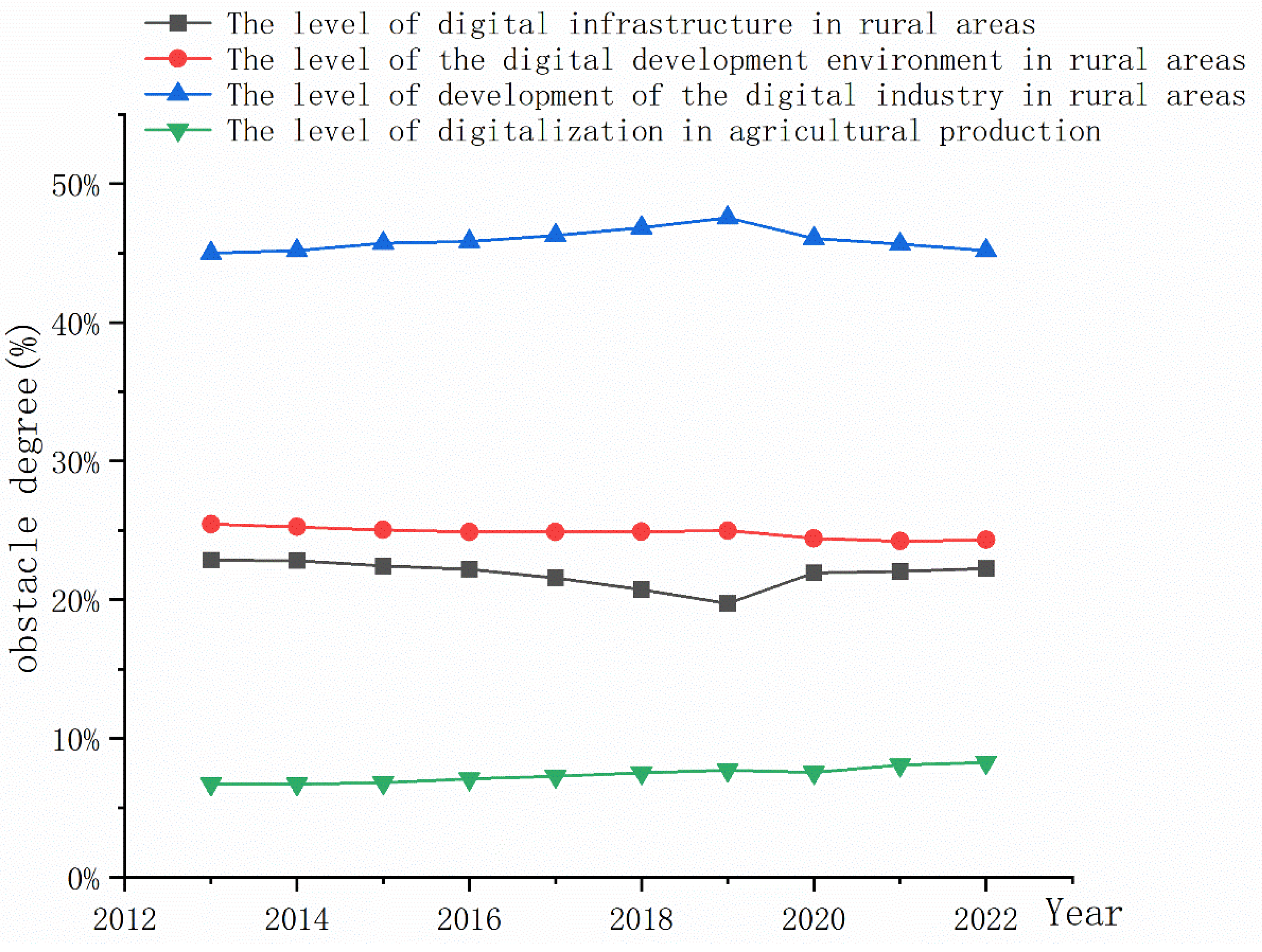
| Subsystems | Primary Index | Secondary Index | Unit | Data Source or Calculation Formula |
|---|---|---|---|---|
| The level of digital infrastructure in rural areas | The level of Internet development | The number of broadband access users in rural areas (X1) | Ten thousand people | China’s Macroeconomic Database |
| The average number of computers per 100 households among rural residents (X2) | Size | China’s Macroeconomic Database | ||
| The number of mobile Internet users in rural areas (X3) | Ten thousand people | The number of mobile Internet users × rural population/total population | ||
| Digital communication capabilities | The average number of mobile phones per 100 households among rural residents (X4) | Size | China’s Macroeconomic Database | |
| Fiber-optic cable length (X5) | Kilometer | China’s Macroeconomic Database | ||
| Level of information infrastructure development | Agricultural meteorological observation workload (X6) | Size | China’s Macroeconomic Database | |
| Volume of rural postal and telecommunications services (X7) | Hundred million yuan | Total volume of postal and telecommunications services × rural population/total population | ||
| The level of the digital development environment in rural areas | Consumption situations of rural residents | Per capita disposable income of rural residents (X8) | Yuan | China’s Macroeconomic Database |
| Per capita expenditure on transportation and communication among rural residents (X9) | Yuan | China’s Macroeconomic Database | ||
| Per capita healthcare expenditure among rural residents (X10) | Yuan | China’s Macroeconomic Database | ||
| Living conditions of rural residents | Rural radio program coverage rate (X11) | % | China’s Macroeconomic Database | |
| Rural TV program coverage rate (X12) | % | China’s Macroeconomic Database | ||
| Number of village health clinics (X13) | Size | China’s Macroeconomic Database | ||
| Local government fiscal expenditures | Local government science and technology expenditures (X14) | Hundred million yuan | National Bureau of Statistics | |
| Local government transportation expenditures (X15) | Hundred million yuan | National Bureau of Statistics | ||
| Local government education expenditures (X16) | Hundred million yuan | National Bureau of Statistics | ||
| Local government healthcare expenditure (X17) | Hundred million yuan | National Bureau of Statistics | ||
| The level of development of the digital industry in rural areas | Rural digital basis | Number of Taobao villages (X18) | Size | List of Taobao Villages |
| Proportion of administrative villages with postal services (X19) | % | China’s Macroeconomic Database | ||
| Level of digital transactions | E-commerce procurement amount (X20) | Hundred million yuan | China’s Macroeconomic Database | |
| E-commerce sales amount (X21) | Hundred million yuan | China’s Macroeconomic Database | ||
| The level of digitalization in agricultural production | Degree of agricultural mechanization | Total agricultural machinery power/crop planting area (X22) | Kilowatt hours/hectare | China’s Macroeconomic Database |
| Effective irrigation rate of farmland | Effective irrigated area/crop planting area (X23) | Thousand hectares | China Agricultural and Forestry Database | |
| Degree of electrification in agricultural production | Total output value of agriculture, forestry, animal husbandry, and fishing/rural electricity consumption (X24) | Yuan/kilowatt hours | China Agricultural and Forestry Database |
| Province | 2013 | 2014 | 2015 | 2016 | 2017 | 2018 | 2019 | 2020 | 2021 | 2022 |
|---|---|---|---|---|---|---|---|---|---|---|
| Beijing | 0.087 | 0.095 | 0.104 | 0.109 | 0.125 | 0.134 | 0.142 | 0.136 | 0.154 | 0.159 |
| Tianjin | 0.052 | 0.058 | 0.063 | 0.074 | 0.076 | 0.077 | 0.082 | 0.081 | 0.088 | 0.085 |
| Hebei | 0.139 | 0.15 | 0.162 | 0.178 | 0.205 | 0.236 | 0.272 | 0.264 | 0.29 | 0.305 |
| Shanxi | 0.075 | 0.079 | 0.087 | 0.092 | 0.102 | 0.111 | 0.122 | 0.11 | 0.116 | 0.119 |
| Inner Mongolia | 0.061 | 0.068 | 0.077 | 0.082 | 0.093 | 0.098 | 0.111 | 0.1 | 0.107 | 0.107 |
| Liaoning | 0.077 | 0.085 | 0.092 | 0.101 | 0.108 | 0.114 | 0.119 | 0.107 | 0.114 | 0.116 |
| Jilin | 0.061 | 0.064 | 0.071 | 0.075 | 0.083 | 0.092 | 0.099 | 0.088 | 0.088 | 0.087 |
| Heilong jiang | 0.066 | 0.07 | 0.078 | 0.085 | 0.099 | 0.107 | 0.117 | 0.1 | 0.104 | 0.107 |
| Shanghai | 0.079 | 0.079 | 0.087 | 0.102 | 0.108 | 0.114 | 0.121 | 0.121 | 0.143 | 0.151 |
| Jiangsu | 0.153 | 0.167 | 0.205 | 0.226 | 0.258 | 0.297 | 0.34 | 0.321 | 0.35 | 0.357 |
| Zhejiang | 0.131 | 0.146 | 0.189 | 0.218 | 0.265 | 0.333 | 0.402 | 0.398 | 0.451 | 0.503 |
| Anhui | 0.073 | 0.086 | 0.105 | 0.122 | 0.139 | 0.169 | 0.198 | 0.179 | 0.195 | 0.207 |
| Fujian | 0.088 | 0.1 | 0.114 | 0.121 | 0.14 | 0.161 | 0.19 | 0.181 | 0.201 | 0.218 |
| Jiangxi | 0.071 | 0.081 | 0.092 | 0.098 | 0.118 | 0.139 | 0.158 | 0.149 | 0.161 | 0.169 |
| Shandong | 0.15 | 0.16 | 0.184 | 0.202 | 0.235 | 0.272 | 0.307 | 0.296 | 0.329 | 0.34 |
| Henan | 0.135 | 0.148 | 0.166 | 0.182 | 0.203 | 0.234 | 0.264 | 0.244 | 0.264 | 0.285 |
| Hubei | 0.088 | 0.102 | 0.116 | 0.126 | 0.14 | 0.166 | 0.19 | 0.179 | 0.187 | 0.201 |
| Hunan | 0.098 | 0.107 | 0.119 | 0.13 | 0.152 | 0.178 | 0.203 | 0.184 | 0.194 | 0.208 |
| Guangdong | 0.173 | 0.187 | 0.243 | 0.264 | 0.307 | 0.364 | 0.433 | 0.41 | 0.445 | 0.469 |
| Guangxi | 0.072 | 0.078 | 0.089 | 0.097 | 0.114 | 0.139 | 0.163 | 0.148 | 0.162 | 0.169 |
| Hainan | 0.018 | 0.021 | 0.027 | 0.03 | 0.038 | 0.043 | 0.052 | 0.051 | 0.058 | 0.063 |
| Chongqing | 0.048 | 0.056 | 0.065 | 0.072 | 0.081 | 0.092 | 0.104 | 0.098 | 0.109 | 0.116 |
| Sichuan | 0.135 | 0.149 | 0.172 | 0.184 | 0.206 | 0.238 | 0.269 | 0.245 | 0.262 | 0.279 |
| Guizhou | 0.05 | 0.06 | 0.071 | 0.078 | 0.092 | 0.11 | 0.13 | 0.106 | 0.117 | 0.128 |
| Yunnan | 0.063 | 0.071 | 0.082 | 0.086 | 0.101 | 0.128 | 0.152 | 0.128 | 0.138 | 0.145 |
| Shaanxi | 0.076 | 0.083 | 0.091 | 0.098 | 0.111 | 0.12 | 0.133 | 0.118 | 0.13 | 0.143 |
| Gansu | 0.053 | 0.056 | 0.065 | 0.071 | 0.081 | 0.099 | 0.109 | 0.095 | 0.103 | 0.106 |
| Qinghai | 0.026 | 0.034 | 0.039 | 0.044 | 0.046 | 0.052 | 0.058 | 0.058 | 0.06 | 0.061 |
| Ningxia | 0.025 | 0.029 | 0.035 | 0.039 | 0.045 | 0.052 | 0.057 | 0.056 | 0.059 | 0.057 |
| Xinjiang | 0.055 | 0.06 | 0.069 | 0.075 | 0.082 | 0.093 | 0.104 | 0.095 | 0.107 | 0.116 |
| Eastern region | 0.104 | 0.113 | 0.134 | 0.148 | 0.17 | 0.195 | 0.224 | 0.215 | 0.239 | 0.252 |
| Central region | 0.083 | 0.092 | 0.104 | 0.114 | 0.129 | 0.149 | 0.169 | 0.154 | 0.164 | 0.173 |
| Western region | 0.06 | 0.068 | 0.078 | 0.084 | 0.096 | 0.111 | 0.126 | 0.113 | 0.123 | 0.13 |
| Northern region | 0.076 | 0.083 | 0.092 | 0.1 | 0.113 | 0.126 | 0.14 | 0.13 | 0.141 | 0.146 |
| Southern region | 0.089 | 0.099 | 0.118 | 0.13 | 0.151 | 0.178 | 0.207 | 0.193 | 0.212 | 0.226 |
| National average | 0.083 | 0.091 | 0.105 | 0.115 | 0.132 | 0.152 | 0.173 | 0.162 | 0.176 | 0.186 |
| Region | Category | Indicator Ranking | ||||
|---|---|---|---|---|---|---|
| 1 | 2 | 3 | 4 | 5 | ||
| Eastern region | Barrier factors | X18 | X20 | X21 | X7 | X14 |
| Barrier degree | 26.55% | 9.31% | 9.08% | 7.49% | 7.30% | |
| Central region | Barrier factors | X18 | X20 | X21 | X14 | X7 |
| Barrier degree | 27.11% | 10.48% | 9.86% | 7.70% | 6.87% | |
| Western region | Barrier factors | X18 | X20 | X21 | X14 | X7 |
| Barrier degree | 26.02% | 10.18% | 9.61% | 7.97% | 6.77% | |
| Northern region | Barrier factors | X18 | X20 | X21 | X14 | X7 |
| Barrier degree | 26.38% | 9.96% | 9.52% | 7.97% | 7.06% | |
| Southern region | Barrier factors | X18 | X20 | X21 | X14 | X7 |
| Barrier degree | 26.64% | 9.93% | 9.45% | 7.33% | 7.06% | |
Disclaimer/Publisher’s Note: The statements, opinions and data contained in all publications are solely those of the individual author(s) and contributor(s) and not of MDPI and/or the editor(s). MDPI and/or the editor(s) disclaim responsibility for any injury to people or property resulting from any ideas, methods, instructions or products referred to in the content. |
© 2025 by the authors. Licensee MDPI, Basel, Switzerland. This article is an open access article distributed under the terms and conditions of the Creative Commons Attribution (CC BY) license (https://creativecommons.org/licenses/by/4.0/).
Share and Cite
Lei, M.; Yang, X.; Hong, S.; Wang, D.; Zhang, W.; Chen, H. Sustainable Digital Rural Development: Measurements, Dynamic Evolutions, and Regional Disparities—A Case Study of China. Sustainability 2025, 17, 4250. https://doi.org/10.3390/su17094250
Lei M, Yang X, Hong S, Wang D, Zhang W, Chen H. Sustainable Digital Rural Development: Measurements, Dynamic Evolutions, and Regional Disparities—A Case Study of China. Sustainability. 2025; 17(9):4250. https://doi.org/10.3390/su17094250
Chicago/Turabian StyleLei, Ming, Xinyu Yang, Shuifeng Hong, Dandan Wang, Wei Zhang, and Hui Chen. 2025. "Sustainable Digital Rural Development: Measurements, Dynamic Evolutions, and Regional Disparities—A Case Study of China" Sustainability 17, no. 9: 4250. https://doi.org/10.3390/su17094250
APA StyleLei, M., Yang, X., Hong, S., Wang, D., Zhang, W., & Chen, H. (2025). Sustainable Digital Rural Development: Measurements, Dynamic Evolutions, and Regional Disparities—A Case Study of China. Sustainability, 17(9), 4250. https://doi.org/10.3390/su17094250




